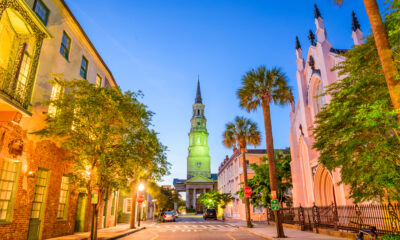New Hampshire
Why Portsmouth Harbor’s lighthouse needed an 80-foot tower on a tiny rock outcrop
Published
6 days agoon

Benjamin Gilman’s 1804 Portsmouth Harbor Lighthouse Construction
Portsmouth Harbor Lighthouse stands as a testament to one man’s skill and many keepers’ grit. Benjamin Clark Gilman, born in 1763, wasn’t just a silversmith and clockmaker.
He was the genius who built the 80-foot wooden tower in 1804 atop Pollock Rock. Life at the lighthouse was no picnic, though.
Early keepers faced constant trouble from nearby soldiers who stole supplies and broke windows with cannon fire.
In 1826, the lantern room caught fire, forcing soldiers to rush in and save the structure.
Even accessing the lighthouse proved tricky, as it required a special footbridge built after the old 1771 lighthouse was torn down.
The historic beacon still guards New Hampshire’s coast today.

A Craftsman’s Hands Built Portsmouth Harbor’s Wooden Lighthouse
Benjamin Clark Gilman landed an amazing job in 1803. The Exeter, New Hampshire local got the contract to build the new Portsmouth Harbor Lighthouse.
Born in 1763, Gilman worked as a silversmith, engraver, watchmaker, clockmaker, engineer, merchant, landlord, and tool maker.
People all over New England talked about his great building skills.
Before the lighthouse, he built water systems in Salem and New London. He later ran the Boston Aqueduct Company from 1810 to 1812.
Workers built the lighthouse on Pollock Rock, about 100 yards east of the old 1771 tower, closer to where ships needed help.

The Tricky Task of Building on Pollock Rock
Workers started the new lighthouse in the fall of 1803. They built the keeper’s house first before working on the main tower.
The spot on Pollock Rock sat right in the shipping channel, making work tough but needed for guiding ships. The location caused problems from the start – it sat outside the fort walls but close enough for cannon fire to reach it.
The team had to figure out how to build a huge structure on a rock in the water and plan how the keeper would travel back and forth.

An 80-Foot Wooden Tower Takes Shape
Gilman’s lighthouse stood 80 feet tall with a wooden tower on a stone base. The bottom measured 40 feet across, getting smaller to just 12 feet at the top.
This height put the light 82 feet above the water, making it visible to ships more than 13 miles away. The team finished building in 1804.
Years later, engineer I. W.P. Lewis called it “an excellent piece of carpentry” that looked good even next to newer lighthouses.
The eight-sided wooden design showed the best lighthouse building of its time.

Getting to the Lighthouse Proved Harder Than Expected
The lighthouse keepers needed a way to reach their workplace on Pollock Rock. Plans called for building a footbridge using wood from the old 1771 lighthouse.
The old tower still stood in late 1805 while they worked out the details. Workers soon found the old wood wasn’t good enough for the new bridge.
After they tore down the old tower in 1807, they sold the wood and bought new materials. The footbridge turned into another big project on top of the lighthouse itself.

Soldiers and Keepers Didn’t Always Get Along
David Duncan kept the light from 1793 to 1820, but his job got harder after the new lighthouse opened. By 1805, he fought often with soldiers from the nearby fort.
Duncan complained they took his supplies. Worse, when the fort fired its cannons for practice or greetings, the blast broke windows in his house.
The military and lighthouse staff worked for different government offices, creating fights instead of teamwork. Things got better in 1807 when workers built a fence between Duncan’s house and the fort.

Fire Almost Destroyed the Wooden Tower
The lighthouse caught fire in 1826, showing how dangerous the job could be. The fire started in the lantern room at the top and spread fast through the wooden structure.
Luckily, soldiers from the fort spotted the flames and rushed to help. They put out the fire before it wrecked the tower.
The U.S. Treasury later paid $20 to replace the soldiers’ clothes damaged while fighting the fire. The same soldiers who once caused problems for the keeper ended up saving the lighthouse.

The Bridge Kept Changing Size Over the Years
The footbridge connecting land to the lighthouse needed constant fixes. Storms, waves, and rot attacked the wooden walkway year after year.
Records show odd changes in its length – 300 feet in 1832, growing to 325 feet by 1847. When workers rebuilt it in 1863, no one wrote down the length.
By 1879, reports listed it as just 160 feet long, but ten years later it stretched 320 feet. No one knows why the length changed so much.
The harsh ocean made keeping up the bridge a never-ending job for lighthouse crews.

New Technology Made the Lighthouse Less Important
As shipping changed, so did the lighthouse. Engineer Lewis noted that after Whaleback Light opened in 1831, Gilman’s tower became less useful.
Workers shortened the tower to 55 feet in 1851. Three years later, they added a modern fourth-order Fresnel lens that made a brighter, more focused beam.
The station got a 1,048-pound fog bell in 1896 to help ships in bad weather.
Each upgrade showed how sailing aids kept improving beyond what Gilman could have thought of when he built the first tower.

The Wooden Lighthouse Served for 74 Years
By 1870, the keeper’s house looked worn out.
The Lighthouse Board asked for $2,000 to replace it. Building started in 1871. Workers tore down the old house and built a new one on the same base by 1872.
The wooden lighthouse tower lasted longer, but its time ran out in 1878. The Annual Report that year talked about replacing Gilman’s 1804 wooden tower with a new cast-iron lighthouse.
After standing for 74 years through storms, fires, and constant sea spray, the wooden tower came down.

A "Stove Pipe" Lighthouse Replaced Gilman’s Wooden Tower
Cast iron lighthouses weren’t common in New England when Portsmouth got its new tower. Not everyone liked the modern look.
John Albee from New Castle called it “hideous” and said it looked like a “corpulent length of stove pipe. ” The lighthouse wore a reddish-brown paint job until 1902, when workers painted it white.
Despite the criticism, the tower featured fancy touches like Italianate hoodmolds above arched windows and decorative brackets holding up the iron-railed platform.
The new tower showed how the Lighthouse Board wanted structures that lasted longer with less upkeep.

Gilman’s Legacy Lives On Beyond Portsmouth Harbor
Benjamin Clark Gilman died on October 13, 1835, leaving behind amazing examples of early American craftsmanship.
His hydraulic engineering work included water systems made by boring holes through logs and connecting them to move water through towns.
The Currier Museum of Art owns several silver spoons he made, along with a carriage pedometer and surveyor’s compass engravings that show his skill with precision instruments.
His Portsmouth Harbor Lighthouse guided ships safely for 74 years before technology moved on. Today, the cast iron tower that replaced his wooden structure still stands as a testament to changing lighthouse design.

Visiting Portsmouth Harbor Light, New Hampshire
Portsmouth Harbor Light at 25 Wentworth Road in New Castle is currently closed due to storm damage, but you can view Benjamin Clark Gilman’s 1804 engineering marvel from Great Island Common town park at 301 Wentworth Road.
Friends of Portsmouth Harbor Lighthouses offers sunset cruises June 20 and 27, 2025, plus a Five Lighthouse Cruise from Rye Harbor on September 14. A capital campaign is rebuilding the 84-foot footbridge.
This article was created with AI assistance and human editing.
Read more from this brand:
John Ghost is a professional writer and SEO director. He graduated from Arizona State University with a BA in English (Writing, Rhetorics, and Literacies). As he prepares for graduate school to become an English professor, he writes weird fiction, plays his guitars, and enjoys spending time with his wife and daughters. He lives in the Valley of the Sun. Learn more about John on Muck Rack.


15 mountain towns in America where fall feels like a painting

This Connecticut submarine museum boasts the Cold War’s most desperate shopping trip

This Colorado town was literally built to shame its sinful neighbor

The drive that shows Maryland like you’ve never seen before

If You Understand These 14 Slang Terms, You’re Definitely from Arkansas

12 Reasons Why You Should Never Ever Move to Florida

Best national parks for a quiet September visit

In 1907, Congress forced Roosevelt to put God back on U.S. coins. Here’s why.

The radioactive secret White Sands kept from New Mexicans for 30 years

America’s most famous railroad photo erased 12,000 Chinese workers from history
Trending Posts

 Pennsylvania4 days ago
Pennsylvania4 days agoHere Are 12 Things People from Pennsylvania Do That Seem Insane To Everyone Else

 North Carolina5 days ago
North Carolina5 days agoHere Are 12 Things People from North Carolina Do That Seem Insane To Everyone Else

 Maine6 days ago
Maine6 days agoThe ruins of a town that time forgot are resting in this Maine state park

 New York5 days ago
New York5 days agoHere Are 12 Things People from New York Do That Seem Insane To Everyone Else

 South Carolina3 days ago
South Carolina3 days agoHere Are 12 Things People from South Carolina Do That Seem Insane To Everyone Else

 Ohio5 days ago
Ohio5 days agoHere Are 12 Things People from Ohio Do That Seem Insane To Everyone Else

 Georgia6 days ago
Georgia6 days agoThis plantation’s slave quarters tell Georgia’s slowest freedom story

 New Hampshire6 days ago
New Hampshire6 days agoHere Are 12 Things People from New Hampshire Do That Seem Insane To Everyone Else
